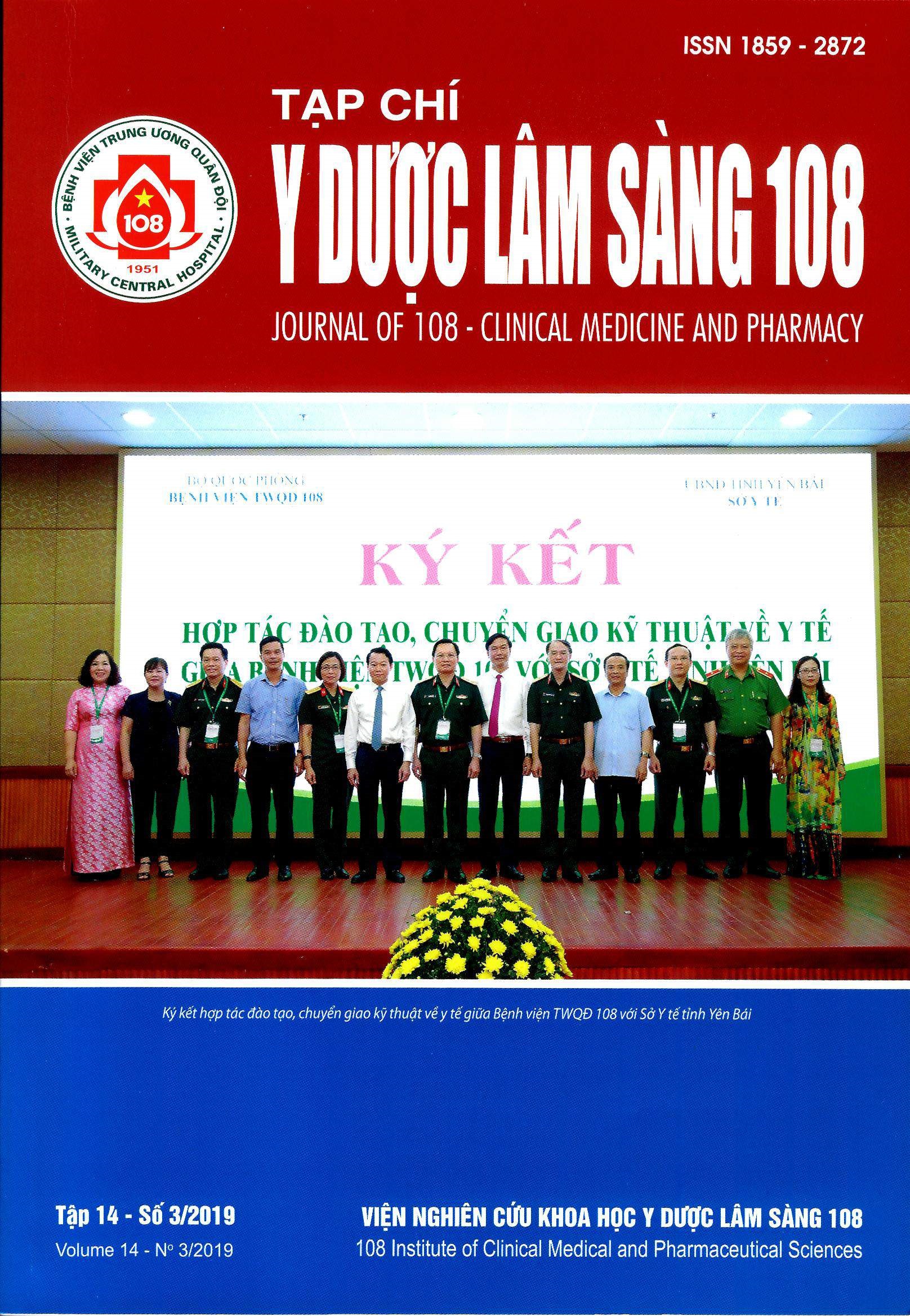Đặc điểm hình ảnh và giá trị chẩn đoán của 18F-FDG PET/CT ở bệnh nhân ung thư tuyến giáp thể biệt hóa sau phẫu thuật có thyroglobulin cao và xạ hình toàn thân với 131I âm tính
Main Article Content
Keywords
Tóm tắt
Mục tiêu: Tìm hiểu đặc điểm hình ảnh và giá trị chẩn đoán của 18F-FDG PET/CT ở bệnh nhân ung thư tuyến giáp thể biệt hóa sau phẫu thuật có thyroglobulin (Tg) cao và xạ hình toàn thân với 131I âm tính. Đối tượng và phương pháp: Nghiên cứu mô tả cắt ngang trên 109 bệnh nhân ung thư tuyến giáp thể biệt hóa sau phẫu thuật. Bệnh nhân được chụp 18F-FDG PET/CT phát hiện tổn thương tái phát, di căn. Đối chiếu kết quả PET/CT với kết quả mô bệnh học và theo dõi lâm sàng sau chụp PET/CT để xác định giá trị chẩn đoán của PET/CT. Kết quả: PET/CT phát hiện được 294 tổn thương với kích thước và SUV trung bình tương ứng là 14,0mm và 9,3g/ml. Vị trí tổn thương được phát hiện nhiều nhất là hạch cổ, trung thất, giường tuyến giáp và phổi. 78% bệnh nhân có kết quả PET/CT dương tính với tỷ lệ dương tính thật, dương tính giả, âm tính thật và âm tính giả tương ứng là 92,9%, 7,1%, 75% và 25%. PET/CT có độ nhạy, đặc hiệu, và độ chính xác trong chẩn đoán ung thư tuyến giáp tái phát di căn tương ứng là 92,9%, 75% và 89%. SUVmax 5,6ng/ml là ngưỡng chẩn đoán ung thư tuyến giáp tái phát, di căn phù hợp nhất. Kết luận: 18F-FDG PET/CT là phương pháp chẩn đoán hình ảnh có giá trị trong phát hiện tái phát, di căn ở BN UTTG biệt hóa sau phẫu thuật có Tg cao và xạ hình toàn thân với 131I âm tính.
Từ khóa: 18F-FDG PET/CT, ung thư tuyến giáp biệt hóa, thyroglobulin cao, xạ hình toàn thân với 131I âm tính.
Article Details
Các tài liệu tham khảo
2. Basu S, Dandekar M, Joshi A, D'Cruz A (2015) Defining a rational step-care algorithm for managing thyroid carcinoma patients with elevated thyroglobulin and negative on radioiodine scintigraphy (TENIS): Considerations and challenges towards developing an appropriate roadmap. Eur J Nucl Med Mol Imaging 42: 1167-1171.
3. Caetano R, Bastos CRG, de Olivera IAG et al (2016) Accuracy of positron emission tomography and positron emission tomography-CT in the detection of differentiated thyroid cancer recurrence with negative 131I whole-body scan results: A meta-analysis. Head Neck 38: 316-327.
4. Chung JK, So Y, Lee JS et al (1999) Value of FDG PET in papillary thyroid carcinoma with negative l3lI whole-body scan. J NucI Med 40: 986-992.
5. Vural GU, Akkas BE, Erkamak N et al (2012) Prognostic significance of FDG PET/CT on the follow-up of patients of differentiated thyroid carcinoma with negative 131I whole-body scan and elevated thyroglobulin levels correlation with clinical and histopathologic characteristics and long-term follow-up data. Clin Nucl Med 37: 953-959.
6. Kunawudhi A, Pak-art R, Keelawat S et al (2012) Detection of subcentimeter metastatic cervical lymph node by 18F-FDG PET/CT in patients with well-differentiated thyroid carcinoma and high serum thyroglobulin but negative 131I whole-body scan. Clin Nucl Med 37(6): 561-567.
7. Iagaru A, Kalinyak JE, McDougall R (2007) 18F-FDG PET/CT in the management of thyroid cancer. Clin Nucl Med 32: 690-695.
8. Na SJ, Yoo IR, O JH et al (2012) Diagnostic accuracy of 18F-fluorodeoxyglucose positron emission tomography/computed tomography in differentiated thyroid cancer patients with elevated thyroglobulin and negative 131I whole body scan: Evaluation by thyroglobulin level. Ann Nucl Med 26: 26-34.
9. Ozkan E, Aras G, Kucuk NO (2013) Correlation of 18F-FDG PET/CT findings with histopathological results in differentiated thyroid cancer patients who have increased thyroglobulin or antithyroglobulin antibody levels and negative 131I whole-body scan results. Clin Nucl Med 38: 326-331.
10. Ha LN, Bieu BQ, Son MH (2016) Value of dedicated head and neck 18F-FDG PET/CT protocol in detecting recurrent and metastatic lesions in post-surgical differentiated thyroid carcinoma patients with high serum thyroglobulin level and negative 131I whole-body scan. Asia Oceania J Nucl Med Biol 4(1): 12-18.
11. Stangierski A, Kaznowski J, Wolinski K et al (2016) The usefulness of fluorine-18 fluorodeoxyglucose PET in the detection of recurrence in patients with differentiated thyroid cancer with elevated thyroglobulin and negative radioiodine whole-body scan. Nucl Med Commun 37(9): 935-938.
12. Giovanella L, Trimboli P, Verburg FA et al (2013) Thyroglobulin levels and thyroglobulin doubling time independently predict a positive 18F-FDG PET/CT scan in patients with biochemical recurrence of differentiated thyroid carcinoma. Eur J Nucl Med Mol Imaging 40: 874-880.
13. Choi SJ, Jung KP, Lee SS et al (2016) Clinical usefulness of F-18 FDG PET/CT in papillary thyroid cancer with negative radioiodine scan and elevated thyroglobulin level or positive anti-thyroglobulin antibody. Nucl Med Mol Imaging 50: 130-136.
 ISSN: 1859 - 2872
ISSN: 1859 - 2872
